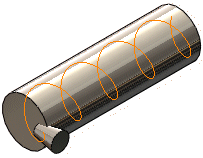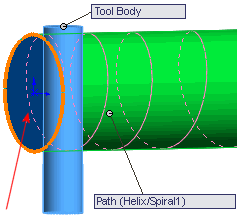Sweep PropertyManager
Set the PropertyManager options based on the type of sweep feature. See Sweep Overview for more information about sweeps.
Profile and Path
|
Profile sweep. Creates a sweep using a profile and path.
|
|
|
|
|
Solid sweep (cut sweeps only). Creates a cut-sweep using a tool body and path. The most common usage is in creating cuts around cylindrical bodies. This option would also be useful for end mill simulation.
For cut sweeps only, when you select Solid sweep, the path must be tangent within itself (no sharp corners) and begin at a point on or within the tool body profile.
|
|
|
|
|
Tool body and path
|
Cut sweep
|
|

|

|
|
|
|
Note how Solid sweep handles a tool body following a helix path:
When you select Follow path for the Orientation/twist type, and None for Path alignment type, the tool body correctly follows the tangents of the helix path.
|
|

|
|
|
|
To keep the tool body perpendicular to a reference as it follows a helix path, select Direction Vector for Path alignment type, then select a direction to which the tool body remains perpendicular, for example, the normal to the planar end face of a cylinder.
|
|

|
|
The tool body remains parallel to the end face as it follows the helix path along the cylinder. This functionality is important for the tool machining market.
|
|

|
-
Profile  . Sets the sketch profile (section) used to create the sweep. Select the profile sketch in the graphics area or FeatureManager design tree. The profile must be closed for a base or boss sweep feature. The profile may be open or closed for a surface sweep feature.
. Sets the sketch profile (section) used to create the sweep. Select the profile sketch in the graphics area or FeatureManager design tree. The profile must be closed for a base or boss sweep feature. The profile may be open or closed for a surface sweep feature.
-
Tool body  (solid cut sweeps only). The tool body must be convex, not merged with the main body, and consist of:
(solid cut sweeps only). The tool body must be convex, not merged with the main body, and consist of:
-
-
A revolved feature that consists of analytical geometry only, such as lines and arcs.
-or-
-
A cylindrical extruded feature.
-
Path  . Sets the path along which the profile sweeps. Select the path sketch in the graphics area or FeatureManager design tree. The path can be open or closed, and can be a set of sketched curves contained in one sketch, a curve, or a set of model edges. The start point of the path must lie on the plane of the profile.
. Sets the path along which the profile sweeps. Select the path sketch in the graphics area or FeatureManager design tree. The path can be open or closed, and can be a set of sketched curves contained in one sketch, a curve, or a set of model edges. The start point of the path must lie on the plane of the profile.
 Neither the section, the path, nor the resulting solid can be self-intersecting.
Neither the section, the path, nor the resulting solid can be self-intersecting.
Options
 of Orientation/twist control
of Orientation/twist control
-
Path alignment type (Available with Follow Path selected in Orientation/twist type). Stabilizes the profile when small and uneven curvature fluctuations along the path cause the profile to misalign. Options are:
-
-
None. Aligns the profile normal to the path. No correction is applied.
-
Minimum Twist (For 3D paths only). Prevents the profile from becoming self-intersecting as it follows the path.
-
Direction Vector. Aligns the profile in the direction selected for Direction Vector. Select entities to set the direction vector.
-
All Faces. When the path includes adjacent faces, makes the sweep profile tangent to the adjacent face where geometrically possible.
-
Direction Vector  (Available with Direction Vector selected in Path alignment type). Select a plane, planar face, line, edge, cylinder, axis, a pair of vertices on a feature, and so on to set the direction vector.
(Available with Direction Vector selected in Path alignment type). Select a plane, planar face, line, edge, cylinder, axis, a pair of vertices on a feature, and so on to set the direction vector.
-
Merge tangent faces. If the sweep profile has tangent segments, causes the corresponding surfaces in the resulting sweep to be tangent. Faces that can be represented as a plane, cylinder, or cone are maintained. Other adjacent faces are merged, and the profiles are approximated. Sketch arcs may be converted to splines.
-
Show preview. Displays a shaded preview of the sweep. Clear to display only the profile and path.
-
Merge result. Merges the solids into one body.
-
Align with end faces. Continues the sweep profile up to the last face encountered by the path. The faces of the sweep are extended or truncated to match the faces at the ends of the sweep without requiring additional geometry. This option is commonly used with helices.

Guide Curves
 The guide curve must be coincident with the profile or with a point in the profile sketch.
The guide curve must be coincident with the profile or with a point in the profile sketch.
Start/End Tangency
Thin Feature
Select to create a thin feature sweep. 
Feature Scope
Specifies which bodies you want the feature to affect. See Feature Scope in Multibody Parts.